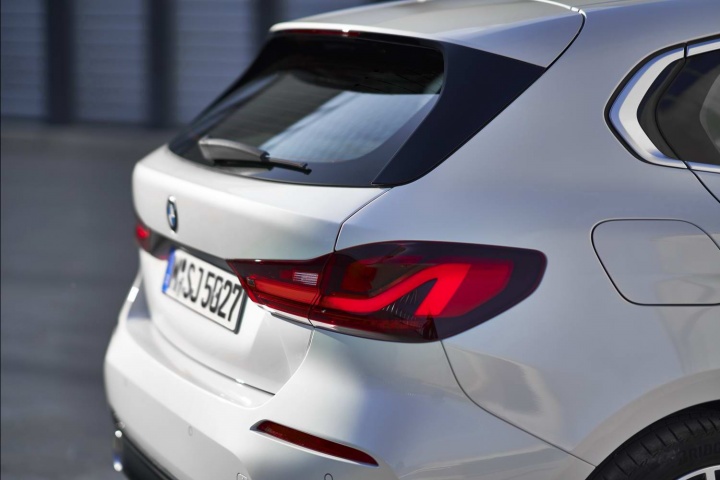What's the news?
BMW has taken the covers off its third-generation 1 Series hatchback. From car enthusiasts' point of view, the biggest news is that the 1 Series is no longer the only rear-wheel-drive car in the class, as it moves to a front-drive platform, but the majority of 1 Series buyers will be more interested in the increased space and a serious ramp up in technology. The first public outings for the new 1 Series will be at BMW's '#NEXTGen' event in Munich on 25-27 June and the Frankfurt Motor Show in September. Officially, the 1 Series goes on sale before the end of this year, but don't expect to see many in Ireland before the '201' plate change in January 2020. Prices are expected to start in the region of €32,000.
Exterior
That move away from rear-wheel drive has meant a significant change in the proportions of the BMW 1 Series. Gone is the long bonnet and 'cab-back' profile, replaced by something altogether more in line with the rest of the hatchback class. It's also worth noting that the new 1 Series will be offered in five-door format only. In terms of dimensions, the 2020 car is five millimetres shorter than its predecessor with a 20mm shorter wheelbase. It is wider though, by 34mm, and higher, by 13mm.
Up front, the 1 Series lights (LED daytime running lights as standard, with full LED units optional) slant back distinctively, seemingly pointing at the enlarged single-piece radiator grille. The side view is free from unnecessary adornment, though the window line clearly rises to the rear in a new interpretation of BMW's characteristic 'Hofmeister kink'. From the back of the car, the extra width gives the 1 Series decent presence, as do the BMW 3 Series-like rear lights (though full-LED units are optional for the 1 Series). Alloy wheel sizes vary from 16- to 19-inch in diameter depending on model and options.
The range-topping M135i version gets an M Performance visual makeover including a unique mesh-like grille up front, plenty of Cerium Grey detailing, large twin-exit exhausts, a larger roof spoiler and bespoke alloy wheels.
Interior
Passengers in the rear of the new 1 Series will be glad of the extra space - made possible by the move to a front-drive platform, despite the reduction in length and wheelbase. Along with some 33mm more kneeroom, the raised floor section in the back (called the transmission tunnel) has been reduced in size and there's a little more width and height in the cabin, too. The rear seat back splits and folds 60:40 as standard and can be upgraded to a 40:20:40 load-through layout. The boot itself is wider at its minimum point than before and, at 380 litres, holds 20 litres more than the old car. Maximum volume with the rear seats folded is 1,200 litres.
Up front, there's more elbowroom than before and a completely new dashboard design. Base models don't get the full BMW Live Cockpit Professional system with its two 10.25-inch screens (one in front of the driver instead of analogue instruments and another, a touchscreen, in the middle of the car), but BMW Live Cockpit is included with plenty of customisation available. The iDrive rotary controller has been redesigned, as has the climate controls, in line with other recently launched BMW models.
In a first for BMW, as well as the 1 Series, it will be possible to specify backlit trim strips for the interior in a variety of finishes. The light colour and brightness can be adjusted by the driver. Three different designs of front seat are available, along with a wide choice of upholstery.
Mechanicals
BMW has detailed five of the 1 Series models as the launch offerings. On the diesel side, buyers choose between the 116d, 118d and 120d xDrive. The 116d is the only version using BMW's 1.5-litre three-cylinder turbodiesel, putting out 116hp and 270Nm of torque. Fitted with a six-speed manual gearbox or a seven-speed, dual-clutch auto, it emits between 100- and 110g/km CO2. The 118d and 120d use BMW's new twin-turbo four-cylinder 2.0-litre diesel, mated to either a six-speed manual gearbox or eight-speed automatic. The former's vital stats include 150hp, 350Nm and between 108- and 116g/km. The 120d is only available with xDrive four-wheel drive and an eight-speed auto. It makes 190hp, 400Nm of torque, can do 0-100km/h in seven seconds dead and emits between 117- and 119g/km.
Meanwhile, the BMW 118i uses a 1.5-litre, three-cylinder turbocharged petrol engine producing up to 140hp and 220Nm of torque. It emits as low as 114g/km.
Topping the range is the BMW M135i xDrive, classed as an M Performance Vehicle. It shares its powertrain with the recently launched BMW X2 M35i and can do 0-100km/h in just 4.8 seconds, while emitting between 155- and 162g/km of CO2.
Three different suspension variants are available, from the standard system to the 10mm lower M Sport option and then two-stage variable damper control. All versions of the new 1 Series employ a multi-link rear axle.
Anything else?
The BMW 1 Series is the first car to benefit from the clever new traction control strategy that debuted on the BMW i3s, which the company calls 'actuator contiguous wheel slip limitation' - or ARB for short. BMW claims that it works so well that the driver perceives that wheel spin is controlled ten times faster. It works in conjunction with BMW Performance Control, which applies brakes to the inside wheels in a corner before actual slip has occurred, in a bid to enhance stability and driving enjoyment. All this is standard across the new 1 Series line-up.
Speaking of which, early indications are that the range will kick-off at €32,330 for the 118i SE on the petrol side of things or €33,100 for the 116d SE. Sport, M Sport and M Sport Plus are the trim levels.







































